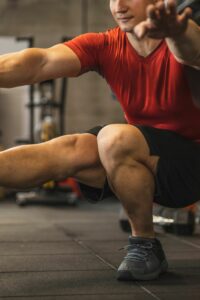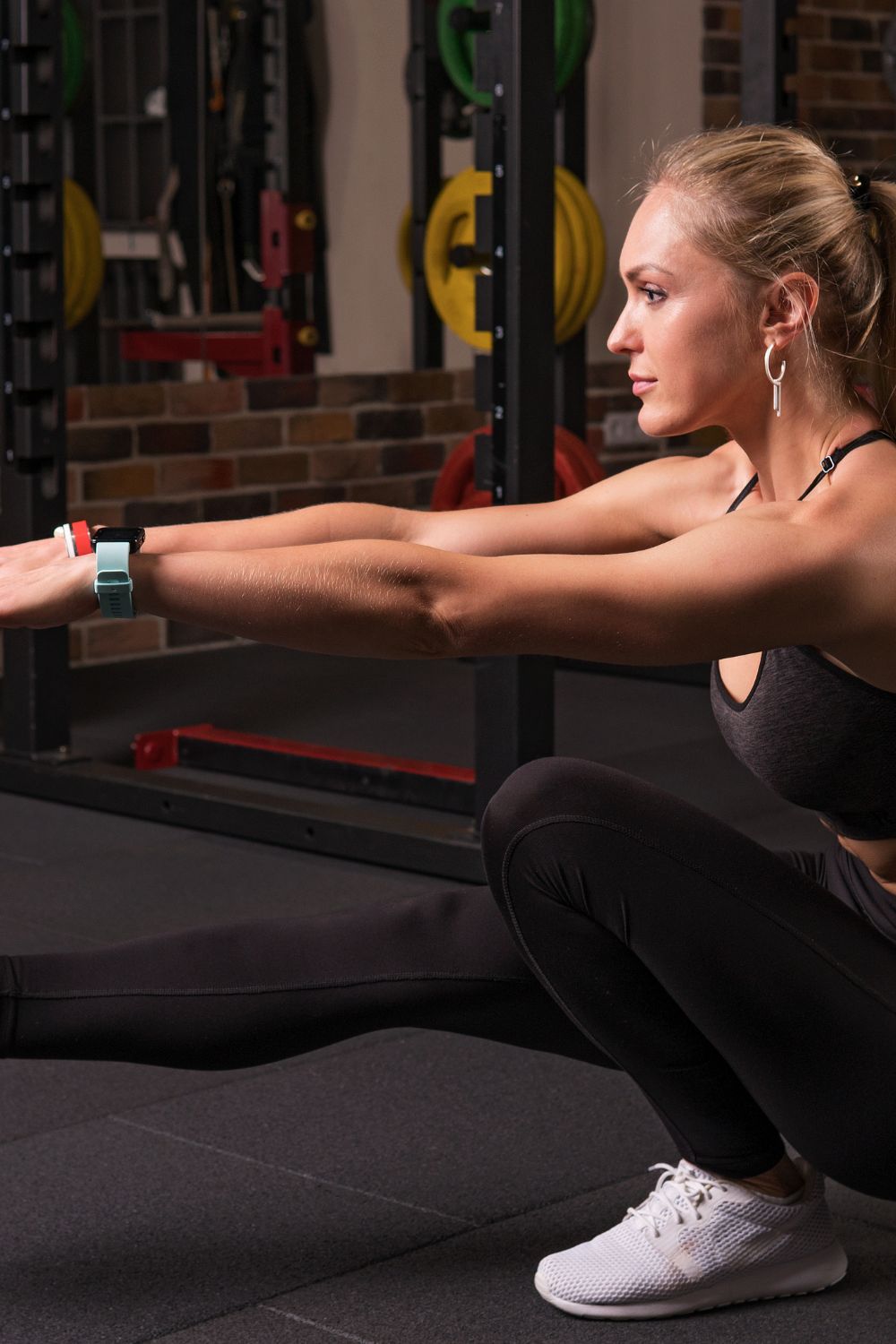If you’ve ever attempted a one-leg squat and experienced your left leg shaking or struggled to bear weight, you’re not alone. Many individuals encounter this challenge, and it can be a frustrating experience. In this comprehensive guide, we will delve into the reasons behind leg shaking during one-leg squats, explore whether it’s normal, and provide practical solutions to improve your stability and strength. Let’s address your concerns and help you on your journey to mastering this exercise.
Why Does Your Left Leg Shake During One-Leg Squats?
The Mechanics of a One-Leg Squat
Before we dive into the causes of leg shaking, it’s essential to understand the mechanics of a one-leg squat. This exercise, also known as a pistol squat, demands exceptional balance, strength, and flexibility. You’re essentially supporting your entire body weight on one leg while lowering yourself into a deep squatting position.
As you descend, your muscles, tendons, and ligaments work together to stabilize your knee, hip, and ankle joints. This complex coordination can be challenging, especially if you’re new to the exercise. Now, let’s explore why your left leg might shake during this movement.
Possible Causes of Leg Shaking
1. Muscle Fatigue and Weakness
One of the most common reasons for leg shaking during one-leg squats is muscle fatigue and weakness. Your leg muscles, particularly your quadriceps, hamstrings, and calf muscles, are working overtime to maintain balance and control your descent. If these muscles are underdeveloped or tired, they may tremble as they struggle to support your body.
2. Poor Balance and Stability
Balance and stability are fundamental in performing one-leg squats. Your nervous system, including proprioceptors and vestibular sensors, plays a crucial role in maintaining equilibrium. If your body’s balance mechanisms are not finely tuned, you may experience leg shaking as your brain tries to adjust and control your posture.
3. Lack of Flexibility
Flexibility in your hip, knee, and ankle joints is essential for a smooth one-leg squat. Limited range of motion in these joints can lead to compensatory movements, causing imbalance and leg shaking.
4. Overexertion
Pushing yourself too hard or attempting advanced variations of the one-leg squat before you’re ready can lead to leg shaking. Overexertion can strain your muscles and make it challenging to maintain proper form, resulting in trembling legs.

Is Leg Shaking Normal?
Understanding the Spectrum
Now that we’ve explored the potential causes of leg shaking, let’s address the question: is it normal? The short answer is yes, but it depends on the severity and frequency of the shaking.
Mild leg shaking during one-leg squats is relatively common, especially when you’re new to the exercise. It’s your body’s way of adapting to the challenge and building the required strength and stability. In this context, consider it a sign of progress rather than a problem.
However, if the shaking is severe, persistent, or accompanied by pain, it’s essential to pay attention. Excessive leg shaking can indicate issues that need to be addressed, such as muscle imbalances or joint problems.
Tips to Reduce Leg Shaking During One-Leg Squats
1. Build Leg Strength
To reduce leg shaking, you need to strengthen the muscles involved in one-leg squats. Focus on exercises that target your quadriceps, hamstrings, and calf muscles. Some effective strength-building exercises include squats, lunges, leg presses, and calf raises.
2. Improve Balance and Stability
Enhancing your balance and stability is key to conquering one-leg squats. Incorporate balance training exercises into your routine, such as single-leg stands, yoga poses, and stability ball exercises. These will help fine-tune your nervous system and improve your ability to control your leg’s movements.
3. Enhance Flexibility
Work on your flexibility by incorporating stretching routines that target your hip, knee, and ankle joints. Regular stretching can increase your range of motion and prevent compensatory movements that lead to leg shaking.
4. Progress Gradually
Avoid overexertion by progressing gradually in your one-leg squat journey. Start with simpler variations and gradually work your way up to more challenging ones. This approach allows your muscles and nervous system to adapt without excessive stress.
The Importance of Proper Form
Maintaining Form and Technique
Regardless of whether you experience leg shaking or not, proper form is essential during one-leg squats. Focusing on technique ensures that you target the right muscles and minimize the risk of injury. Here are some key form tips:
- Keep your back straight and chest up.
- Extend your free leg forward for balance.
- Lower yourself slowly and controlled.
- Maintain a neutral spine position.
- Engage your core for stability.
Common Mistakes to Avoid
Common Mistakes During One-Leg Squats
There are a few common mistakes that can lead to leg shaking and hinder your progress. Let’s take a look at these mistakes and how to avoid them:
1. Allowing Your Knee to Cave Inward
When your knee collapses inward during a one-leg squat, it can put excessive stress on the joint and lead to instability. To prevent this, focus on keeping your knee aligned with your foot throughout the movement.
2. Leaning Too Far Forward
Leaning too far forward can disrupt your balance and cause leg shaking. To avoid this, maintain an upright posture and engage your core muscles to stabilize your body.
3. Neglecting Mobility Work
Neglecting mobility exercises can limit your range of motion and make one-leg squats more challenging. Incorporate hip, knee, and ankle mobility drills into your warm-up and cooldown routines to improve flexibility.
Conclusion
In summary, experiencing leg shaking during one-leg squats is a common challenge, especially for those new to the exercise. It can be attributed to muscle fatigue, poor balance, limited flexibility, and overexertion. While mild leg shaking is normal and a sign of progress, excessive or painful shaking should not be ignored.
To address this issue, focus on strengthening your leg muscles, improving balance and stability, enhancing flexibility, and progressing gradually in your training. Always prioritize proper form and technique, and be aware of common mistakes that can lead to leg shaking.
By following these guidelines and incorporating the recommended external resources, you can reduce leg shaking, increase your one-leg squat proficiency, and enjoy the benefits of improved leg strength and stability. Keep challenging yourself and stay committed to your fitness journey – you’ll be mastering one-leg squats in no time!
A comparison tabular on this
| Aspect | Causes of Leg Shaking | Is Leg Shaking Normal? | Tips to Reduce Leg Shaking | The Importance of Proper Form | Common Mistakes to Avoid |
|---|---|---|---|---|---|
| Mechanics of a One-Leg Squat | Muscle Fatigue and Weakness, Poor Balance and Stability, Lack of Flexibility, Overexertion | Yes, but depends on severity and frequency. | Build Leg Strength, Improve Balance and Stability, Enhance Flexibility, Progress Gradually | Maintain Form and Technique | Allowing Your Knee to Cave Inward, Leaning Too Far Forward, Neglecting Mobility Work |
| Resources for Improvement | Yoga for Balance and Stability, Strength and Conditioning Exercises | – | – | – | – |
This tabular format provides a quick overview of the main points discussed in the article, making it easier for readers to grasp the essential information at a glance.
glance.
Final words
In your journey to overcome leg shaking during one-leg squats, it’s important to remember that progress takes time and dedication. Experiencing a bit of shaking, especially if you’re new to the exercise, is entirely normal. It’s a sign that your body is adapting and growing stronger.
By understanding the mechanics of the one-leg squat and addressing the common causes of leg shaking, such as muscle fatigue, poor balance, and limited flexibility, you can take significant steps toward improvement. Strengthening your leg muscles, working on your balance and stability, enhancing flexibility, and progressing gradually are key strategies to reduce leg shaking.
Proper form is your foundation, so always prioritize it. And avoid common mistakes like letting your knee cave inward, leaning too far forward, or neglecting mobility work.
In your quest to master one-leg squats, remember that it’s a journey of self-improvement and personal growth. Be patient, stay committed, and celebrate your progress along the way. With dedication and the right approach, you can conquer leg shaking and reap the benefits of increased leg strength and stability. Keep challenging yourself, and you’ll achieve your fitness goals.
Additional Resources for Improvement
H2: External Links to Enhance Your Knowledge
To further enhance your understanding of improving leg stability and reducing shaking during one-leg squats, consider exploring these valuable external resources:
- Yoga for Balance and Stability – This resource provides a collection of yoga poses and practices specifically designed to improve balance and stability, which can be beneficial for your one-leg squat journey.
- Strength and Conditioning Exercises – The American Council on Exercise offers a comprehensive exercise library with detailed instructions on various strength and conditioning exercises that can help you build the necessary leg strength for one-leg squats.

Hey there, it’s Mike Rrsq, the Editor-in-Chief over at Jsquat.com, and I’m absolutely obsessed with all things squat fitness! I’ve been lucky enough to get some serious recognition for my work in this field. With a solid background in the fitness and wellness industry, I’ve been there right from the get-go, helping shape this website into what it is today.
You see, I’m not just the boss around here; I’m also a passionate contributor. I love sharing my insights through my articles, and trust me, they’re not your run-of-the-mill stuff. Each piece I write is a labor of love, filled with my expertise and real-world experience in the fitness universe. So, if you’re into fitness and looking for some inspiration, you’re in the right place!

